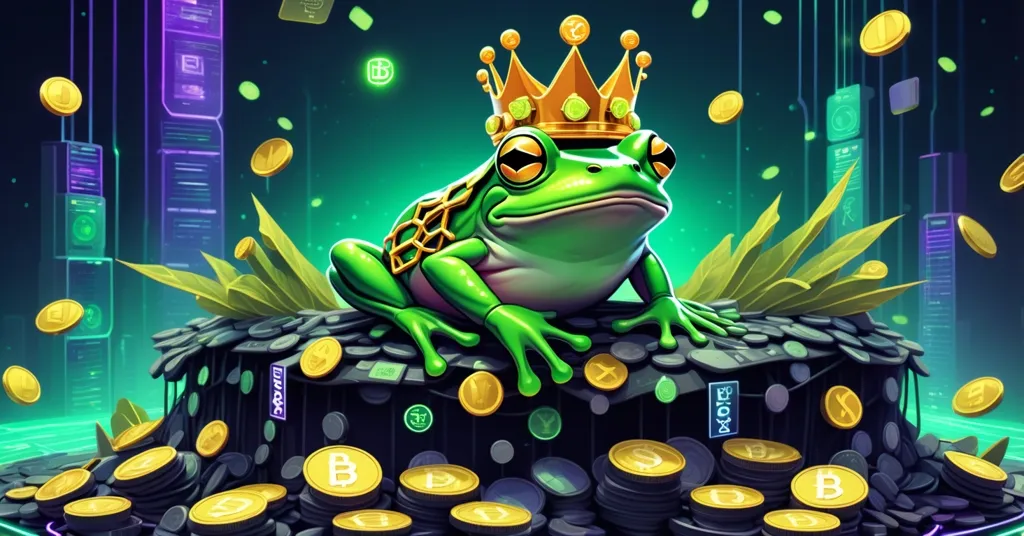Little Pepe Memecoin: $27M Presale Hype or Another Crypto Scam?

Little Pepe Memecoin: Riding the Hype Wave or Heading for a Wipeout?
Little Pepe (LILPEPE), the latest memecoin to storm the crypto scene, has already racked up a staggering $27 million in its presale while flaunting a near-perfect CertiK audit score of 95.49%. Built on a Layer-2 blockchain for speed and low fees, it’s got the buzz, the tech, and the promise of major exchange listings. But in the snake-oil-filled swamp of memecoins, is this frog-themed token a potential prince or just another scam waiting to hop off with your cash? Let’s dissect the hype, the how-to, and the hard realities.
- Presale Boom: Over $27 million raised, showing wild early investor interest in this Layer-2 memecoin.
- Security Cred: A CertiK audit score of 95.49% hints at solid code, a rare gem in memecoin land.
- Tech Edge: Layer-2 blockchain tech aims for faster trades and cheaper fees compared to Ethereum’s mainnet.
Presale Hype: $27 Million and Counting
The numbers behind Little Pepe are jaw-dropping for a memecoin still in its infancy. With over $27 million raised during its presale, this project has tapped into the FOMO frenzy that defines speculative crypto markets in 2023. For context, that figure rivals some of the early funding rounds of now-legendary memecoins like Shiba Inu, which hit a peak market cap of over $40 billion in 2021 on pure community hype. Little Pepe sweetens the pot with a $777k giveaway and over 15 ETH in prizes for top presale buyers, a classic tactic to fuel engagement and keep the momentum rolling. Add to that a zero-tax policy—no hidden fees on buys or sells—and you’ve got a recipe that, on paper, screams “investor-friendly.”
Security is another feather in LILPEPE’s cap. A 95.49% CertiK score from a respected blockchain auditing firm isn’t just high; it’s exceptional for a memecoin, where shoddy code and rug pulls are the norm rather than the exception. This suggests the project’s smart contracts—the automated code that governs token transactions—have been rigorously vetted for vulnerabilities. But let’s not pop the champagne yet; audits check code, not the hearts of the developers behind it. The promise of listings on two major exchanges post-launch (though names remain under wraps) further stokes excitement, hinting at broader access and potential price pumps. Still, hype doesn’t equal longevity, and memecoins are notorious for flaming out after the initial buzz.
Layer-2 Tech: Speedy Trades or Just Slick Marketing?
Little Pepe markets itself as a cut above the average memecoin by leveraging a Layer-2 blockchain. For the uninitiated, Layer-2 solutions are secondary networks built on top of Ethereum to tackle its infamous scalability issues. Ethereum’s mainnet often chokes under high demand, leading to sky-high gas fees—those pesky transaction costs that can hit $50 or more during peak times. Layer-2 tech, like Optimism or Arbitrum, processes transactions off the main chain before bundling them back, slashing both time and cost. While LILPEPE’s specific Layer-2 platform isn’t publicly confirmed, the claim is that users will enjoy faster swaps and near-zero fees compared to standard Ethereum trades.
This tech edge could be a game-changer for memecoins, which often spam Ethereum’s mainnet with micro-transactions during hype cycles, driving up costs for everyone. If Little Pepe delivers, it might ease some congestion on Ethereum while making meme trading more accessible. But here’s the rub: Layer-2 isn’t a silver bullet. These networks are still maturing, with risks like lower decentralization or security trade-offs compared to the main chain. And let’s be real—most memecoin buyers don’t care about tech; they’re chasing quick flips. Is this just fancy glitter to distract from a lack of real utility? Without transparency on which Layer-2 solution is in play, skepticism is warranted.
Memecoin Mania: A Brief History of Hype and Hurt
To understand Little Pepe’s place in the crypto zoo, let’s zoom out. Memecoins exploded with Dogecoin in 2013, a joke token that somehow hit a $90 billion market cap at its 2021 peak, fueled by tweets and Reddit memes. Shiba Inu followed, riding the “Dogecoin killer” narrative to billions in value. These success stories mask a graveyard of failures—think SafeMoon, accused of a pump-and-dump scheme, or the Squid Game token, a blatant 2021 rug pull that vanished with millions overnight. The psychological pull is obvious: cheap tokens, viral communities, and dreams of 100x gains lure in the masses, especially during bull runs.
Little Pepe fits this mold perfectly with its $27 million presale and community-driven ethos—think Discord servers and Twitter memes galore. But history screams caution. Most memecoins lack utility beyond speculation; they’re digital lottery tickets, not tech revolutions. While LILPEPE’s Layer-2 angle and audit score offer some differentiation, the core gamble remains unchanged. Will it build a lasting tribe, or join the 90% of tokens that fade into obscurity? If you’re betting on this frog, know the odds are stacked against you.
Buying LILPEPE: A Step-by-Step Guide for Newbies and Vets
So, you’re caught in the hype and want to snag some LILPEPE before the masses? Here’s how to do it without tripping over your own feet. This presale process is fairly standard for Ethereum-based tokens, but I’ll break it down for those just dipping their toes into crypto waters. If you’re looking for a detailed guide on purchasing Little Pepe memecoin, we’ve got the steps laid out below.
- Set Up a Wallet: Download a crypto wallet like MetaMask (a browser extension or app) or Trust Wallet (mobile-friendly). These let you store and manage Ethereum-based tokens and connect to decentralized platforms via Wallet Connect, a protocol for linking wallets to apps.
- Fund Your Wallet: Buy Ethereum (ETH) or USDT (a stablecoin tied to the US dollar) on an exchange like Binance or Coinbase. Transfer it to your wallet. ETH covers token purchases and gas fees—the cost of processing transactions on Ethereum.
- Connect and Swap: Visit littlepepe.com, hit “Connect Wallet,” select your wallet, and follow the prompts to swap ETH or USDT for LILPEPE tokens. Double-check the site’s URL to avoid phishing scams.
- Alternative Route: No crypto yet? Use fiat on-ramps like Ramp Network or Transak on the Little Pepe site to buy ETH directly with a debit or credit card. No KYC (ID verification) is needed, meaning faster access, though be wary of fraud risks with unverified platforms.
- Track Your Tokens: After purchase, tokens show up on the Little Pepe dashboard. Or add them manually to your wallet using the ERC-20 contract address: 0xddc2CbF96836f55ca40b819078F3ecbf1b270315. ERC-20 is just a standard format for tokens on Ethereum, like how PDFs are a standard for documents. Note the 18 decimals setting—it means tokens can be split into tiny fractions for precision. You can’t move or sell them until the claim period post-presale, so sit tight.
Seems simple, right? Still, don’t rush in blind. Always secure your wallet with strong passwords and backup phrases, and never share them. One wrong click in this space, and your funds are gone for good.
Memecoin Risks: Don’t Get Burned by the Frog
Let’s slam on the brakes before you mortgage your house for LILPEPE. Memecoins are the Wild West of crypto—a lawless frontier where fortunes are made and lost on a tweet. While Little Pepe’s audit score and tech claims sound promising, there’s a stench of red flags. The team, despite vague claims of being “non-anonymous” with a meme-space track record, offers zero verifiable details. Transparency matters—Dogecoin’s early community was open and scrappy, building trust over time. If LILPEPE’s creators stay in the shadows, what’s stopping them from dumping their tokens after the hype peaks?
Even that shiny CertiK score isn’t foolproof. Audits vet code, not intent. Plenty of “audited” projects have turned out to be scams—look at SafeMoon, where devs allegedly siphoned millions despite early credibility. And the memecoin track record? Brutal. For every Dogecoin, there are hundreds of dead tokens that burned early adopters. Little Pepe’s disclaimer that this isn’t investment advice isn’t just legalese—it’s a neon sign saying, “Do your own damn research.” Treat this as high-stakes gambling, not a retirement plan.
Devil’s Advocate: Could Little Pepe Actually Matter?
Here’s where I’ll play contrarian. Sure, Little Pepe might be another flash-in-the-pan meme frog, ready to belly-flop into oblivion. But what if it catches the next bull run’s tailwind with those exchange listings? Short-term, it could spike hard, rewarding early gamblers. More broadly, memecoins, for all their absurdity, fill a niche Bitcoin can’t touch. They’re the flashy billboards of crypto, drawing in everyday folks with humor and low entry costs—something Bitcoin’s serious “digital gold” vibe often fails to do. Fiat on-ramps like Ramp Network make LILPEPE a gateway for newcomers who’d never touch a BTC wallet.
As a Bitcoin maximalist, I’ll grudgingly admit this chaos has value. In the spirit of effective accelerationism—pushing tech adoption at breakneck speed—every crazy experiment, even a meme token, drives us toward a decentralized future. Memecoins test wild tokenomics and community governance models that Bitcoin’s rigid design can’t replicate. They’re messy, sure, but they onboard users and stress-test blockchain scalability. Little Pepe’s Layer-2 play could even nudge Ethereum’s ecosystem forward, if it doesn’t just shift spam elsewhere. Just don’t expect it to dethrone BTC as the fortress of decentralized money.
What’s Next for Little Pepe?
Post-presale, Little Pepe faces a gauntlet. Exchange listings sound great, but they don’t guarantee liquidity—plenty of tokens list only to languish with no buyers. Community hype often fades without constant memes or utility to sustain it. Will LILPEPE build a loyal tribe, or crumble under profit-taking by early whales? And if the Layer-2 tech underperforms, user frustration could tank sentiment fast. Then there’s regulatory heat—memecoins are increasingly under scrutiny for pump-and-dump risks. We’ll be watching whether this frog leaps to glory or splats on the pavement. Stay tuned.
Key Takeaways: Unpacking Little Pepe Memecoin
- What is Little Pepe, and why is it turning heads?
LILPEPE is a 2023 memecoin on a Layer-2 blockchain, hyped for raising $27 million in presale, a 95.49% CertiK security score, low fees, and a community focus. Upcoming exchange listings add to the frenzy. - How do I buy LILPEPE tokens during the presale?
Set up a wallet like MetaMask, fund it with ETH or USDT from exchanges like Binance, connect to littlepepe.com, and swap. Or buy ETH directly via Ramp Network or Transak with a card, no KYC needed. - What makes Little Pepe stand out among memecoins?
Its Layer-2 tech promises faster, cheaper trades, a zero-tax policy cuts fees, and a strong audit plus $777k giveaway boost appeal. Still, it’s speculative like most memecoins. - Is Little Pepe a safe investment or a risky gamble?
The CertiK score and team claims offer some credibility, but audits don’t cover developer intent, and memecoins are notorious for rug pulls. Treat it as a high-risk bet and research thoroughly. - Why should Bitcoin fans care about a memecoin like LILPEPE?
While Bitcoin reigns as decentralized money, memecoins onboard new users with accessibility and test blockchain innovations. They’re a wild sideshow, but they push adoption in ways BTC can’t.
Editor’s Note: This content is for informational purposes only and not financial advice. Cryptocurrency investments carry high risk, and past performance or audits do not guarantee future results. Always conduct your own research before investing.



